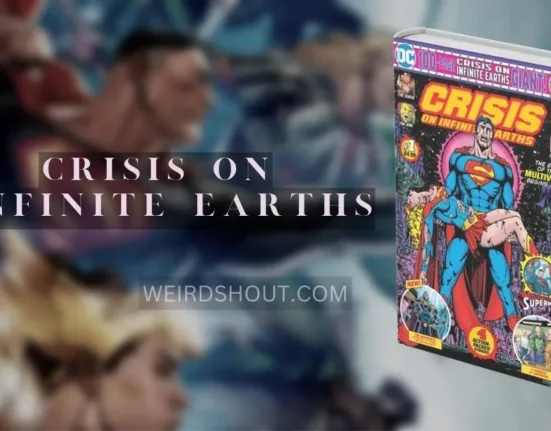All DC comics have been there with us since the company’s start in 1934, and now we have thousands of DC Comics series issues.
Have you recently noticed the universe for the initial moment and gotten hooked?
Do you want to discover everything there is to know about these all DC comics? Trying to decide where to begin reading all Dc comics from the DC universe might be daunting.
If you’re new to DC Comic series and want to enjoy some of the most iconic and popular storylines, you may start with any of the collected editions, which gather numerous issues into a single volume.
Consider the following great stories of all DC comics ever in its history:
- “Watchmen” by Alan Moore and Dave Gibbons
- “The Dark Knight Returns” by Frank Miller
- “The Killing Joke” by Alan Moore and Brian Bolland
- “Crisis on Infinite Earths” by Marv Wolfman and George Perez
If you want to get into the current DC Universe and see what’s going on in the comics, you should start with some of the main series that is presently being produced. Consider the following popular titles:
- “Batman”
- “Superman”
- “Wonder Woman”
- “The Flash”
- “Green Lantern”
If you’re interested in a certain character or team, you should start by reading some of the solo or team-up titles of all DC comics. For example, if you like Batman, you may start with “Batman” or “Detective Comics.” If you like the Justice League, you may start with “Justice League” or “Justice League of America.”
Whatever route you use, bear in mind that comics might be a little perplexing if you’re unfamiliar with the characters and their backstories.
Because those all DC Comics has a vast history and many distinct series and stories that span multiple time periods and other dimensions, the chronological sequencing of DC Comics series can be a little confusing.
That being stated, the timeline below provides a basic summary of some key events in the history of the DC Universe; however, it should be reminded that this timeline is a broad overview and does not include every single event in the DC Universe.
- The Golden Age of Comics (1938-1956)
- The Silver Age of Comics (1956-1970)
- The Bronze Age of Comics (1970-1985)
- The Modern Age of Comics (1985-present)
The Golden Age Comics:
The phrase “Golden Age of Comics” refers to the era from the late 1930s to the mid-1950s when the modern comic book was invented and numerous legendary characters and brands were formed. In the DC Universe, the Golden Age is often regarded to have lasted from 1938 (the year Superman was first published) through 1956. (the year that the last Golden Age superhero team, the Justice Society of America, was officially retired).
All DC Comics (formerly known as National Comics) established many of the characters and themes that are still famous today, including Superman, Batman, Wonder Woman, the Flash, Green Lantern, and many others, during the Golden Age. These characters rose to prominence in their own single comic book series as well as members of superhero teams such as the Justice Society of America and the All-Star Squadron.
The Golden Age is also remembered for its high levels of inventiveness and invention in the comics business. Many of the narrative techniques and traditions that are still in use today were invented during this time period, and the Golden Age is widely regarded as a comics’ golden age.
The following are some major events and milestones from the Golden Age of All DC Comics:
- 1938: Superman is introduced in Action Comics #1
- 1939: Batman is introduced in Detective Comics #27
- 1940: Wonder Woman is introduced in All Star Comics #8
- 1940: The Flash is introduced in Flash Comics #1
- 1940: Green Lantern is introduced in All-American Comics #16
- 1941: The Justice Society of America is introduced in All Star Comics #3
- 1956: The last Golden Age superhero team, the Justice Society of America, is officially retired.
The Silver Age of Comics:
The Silver Age of Comics refers to the period between the mid-1950s and the early 1970s when many legendary characters and brands were resurrected and new ones were launched in all DC comics. In the DC Universe, the Silver Age is commonly thought to have lasted from 1956 (the year the Flash was resurrected in Showcase #4) through 1970. (the year that the last Silver Age superhero team, the Justice League of America, was officially retired).
All DC Comics resurrected and modernized many of the characters and themes launched during the Golden Age throughout the Silver Age. The Flash, who was given a new origin and a new outfit, and the Green Lantern, who was given a new power ring and a new foe in Sinestro, were both given new origins and new costumes. Many new characters and concepts were introduced during the Silver Age, including the Teen Titans, the Legion of Superheroes, and the concept of the universe.
The Silver Age was also a period of enormous inventiveness and invention in the comics business. Many of the storytelling techniques and traditions that are still in use today were invented during this time period, and the Silver Age is frequently regarded as the pinnacle of comics history. The following are some major events and milestones from the Silver Age of Comics:
- 1956: The Flash is revived in Showcase #4
- 1956: The Atom is revived in Showcase #34
- 1956: The Green Lantern is revived in Showcase #22
- 1960: The Justice League of America is introduced in The Brave and the Bold #28
- 1961: The Teen Titans are introduced in The Brave and the Bold #54
- 1961: The Legion of Super-Heroes is introduced in Adventure Comics #247
- 1964: The concept of the multiverse is introduced in The Flash #123
- 1970: The last Silver Age superhero team, the Justice League of America, is officially retired.
The Bronze Age of Comics:
The Bronze Age of Comics refers to the era from the early 1970s to the mid-1980s when many legendary characters and brands were developed further and new ones were launched in all DC comics. In the DC Universe, the Bronze Age is usually thought to have lasted from 1970 (the year the final Silver Age superhero team, the Justice League of America, was formally decommissioned) through 1985. (the year that the last Bronze Age superhero team, the Legion of Super-Heroes, was officially retired).
All DC Comics continued to expand and update many of the characters and themes introduced during the Golden and Silver Ages into the Bronze Age. This includes the reintroduction of characters like the Atom and Hawkman, as well as the introduction of new ones such as Vixen, Firestorm, and Blue Beetle. The Bronze Age also witnessed the development of more adult topics and darker, more realistic visual forms, as well as more socially and politically significant tales.
The Bronze Age was also a period of remarkable inventiveness and invention in the comics business. Many of the storytelling techniques and traditions that are still in use today were invented during this time period, and the Bronze Era is sometimes regarded as the golden age of comics.
The following are some major events and milestones from the Bronze Age of Comics:
- 1970: The Atom is revived in All-New Atom #1
- 1970: The Hawkman is revived in The Brave and the Bold #95
- 1972: Vixen is introduced in Action Comics #521
- 1978: Firestorm is introduced in Firestorm, the Nuclear Man #1
- 1978: Blue Beetle is introduced in Captain Atom #83
- 1981: The Legion of Super-Heroes is revamped in Legion of Super-Heroes #259
- 1984: Crisis on Infinite Earth, a massive crossover event, is published
- 1985: The last Bronze Age superhero team, the Legion of Superheroes, is officially retired.
The Modern Age of Comics:
The phrase “Modern Age of Comics” refers to the period from the mid-1980s to the present, during which many iconic characters and franchises have been produced and new ones have been introduced in all DC comics. In the DC Universe, the Modern Age is widely thought to have begun in 1985 (the year the final Bronze Age superhero team, the Legion of Super-Heroes, was formally decommissioned) and to continue ongoing.
All DC Comics has continued to expand and update many of the characters and themes presented throughout the years in the Modern Age. New characters have been introduced, including Kyle Rayner as Green Lantern, Cassandra Cain as Batgirl, and Renee Montoya as the Question. The growth of more diverse and inclusive tales, as well as the launch of new imprints like Vertigo and Young Animal, has also occurred in the Modern Age.
The Modern Age is also remembered for its high levels of inventiveness and invention in the comics business. Many of the storytelling techniques and traditions that are still in use today were invented during this time period, and the Modern Age is frequently regarded as the pinnacle of all DC comics history.
The following are some significant events and milestones in the Modern Age of Comics:
- 1986: The Batman series is revamped in Batman #404
- 1989: The Sandman series is launched under the Vertigo imprint
- 1993: The Death of Superman story is published
- 1994: The Green Lantern series is revamped in Green Lantern #50
- 1996: The Batman: No Man’s Land storyline is published
- 2002: The Batman: Hush storyline is published
- 2006: The Infinite Crisis crossover event is published
- 2011: The New 52, a massive reboot of the DC Universe, is launched
- 2016: The Rebirth initiative, a soft reboot of the DC Universe, is launched.
One of the most difficult aspects of reading these all DC Comics is the complicated continuity that connects many of the many titles and storylines. Because all DC Comics has been producing comics for a long time, there are frequent references to events and characters from previous storylines that new readers may not be aware of. This might make understanding the context of a specific narrative or character difficult.
Another source of perplexity is the presence of various stories and parallel universes that connect and overlap. For example, numerous versions of the same character, such as Batman, may exist in distinct worlds or timelines. This can make distinguishing which individuals and events are part of the regular continuity and which are part of parallel universes or stories challenging.
Finally, there are several characters and plot threads to keep track of. With so many titles and series to select from, it may be tough to know where to begin or how to strike the appropriate mix between classic stories and current, continuing series.
Overall, while reading all DC Comics might be confounding at times, it can also be a rewarding and delightful experience for anyone willing to put in the time and effort to comprehend the DC Universe’s intricate narrative and rich history.








